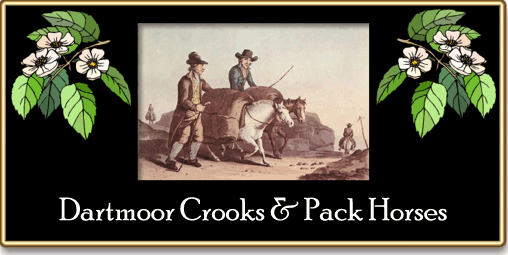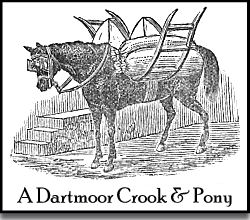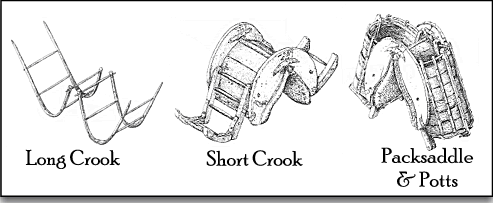
Today if you drive down any Dartmoor road you will meet vans and lorries delivering the many necessities of life either to the villages and towns or from the various business on the moor. There is nothing more frustrating than getting stuck behind such a vehicle especially on the steep hills. But for centuries there has been the requirement for such ‘logistic’ needs of transport, the only difference is that at one time the loads were carried by packhorses or ponies. So if the packhorses or ponies were the ‘tractor units’ of the moor then the crooks were surely the ‘articulated containers’. But what is a ‘crook’ in the Dartmoor sense of the word – simple a few poles lashed together. Crooks were made from two poles, 10ft long, and bent when green into a curve, when dried they were then connected to two horizontal bars. These were then slung over the packsaddle of a pony, one swinging each side to balance the loads. They are used to carry faggots, furze, peat etc. Mrs Bray (1834 p.23) gives her description of a crook in the following words around 1834:
“Imagine the poor donkey, or a half starved horse, laden first with a huge pack-saddle, never intended to bear anything else but a crook; and across this saddle is placed that very machine, which is made of wood, and so constructed as to keep from falling to the ground any load of peat, firewood &cc., that is frequently piled up twice as high as the animal that bears it. At either side of this machine arise two ‘crooked’ pieces of wood, turning outwards like the inverted tusks of the walrus. These in themselves have a somewhat formidable appearance but more so when after they are loaded, the thoughtless driver as to frequently happens, places his pitchfork in an oblique direction from the saddle to one of the shafts of the crook: for thus, whilst the animals are advancing at a brisk pace and in no very regular order, the prong of it may lacerate the leg of any unhappy horseman that meets them, and has not time or dexterity to avoid their onset. The crook is here known by the name of the Devil’s Toothpick.
Clearly once a surplus of food was being grown or other resources produced such as tin there was a need to transport them off the moor. In addition the foundation of medieval abbeys meant that goods were constantly being taken between and from such establishments. In order to do this firstly a network of trackways was needed and at the same time modes of conveying the goods. This meant that the packhorse/pony was being used from very early times. Finberg (1969, p. 82) describes how in the 12th century tenants of Tavistock abbey were using packhorses to convey the corn from the harvest field to the grange, “using his cart if he had one, his packhorse if not. In 1386 Finberg (p.90) notes how three pack horses were bought to fetch sand for the fields at a cost of 19s, 11d. It is also noted (p.132) how by the seventeenth century:
“Farm carts were in more general use… but carriage by packhorse was commoner still. The wooden packsaddle was fitted on each side with a pair or downward-curving willow poles seven or eight feet long, joined by crossbars, and rising fifteen or more inches above the horse’s back. Within these crooks, as they were called, the load of corn, hay or straw was piled.“

Milton ( 2006, p.32)
Writing in 1796, Marshall (1970, p.122) describes the various types of crook, in addition to the standard version there was also what was known as the ‘short crook‘, this made of four pairs of natural bends or ‘knees‘ with the points nearly level with the ridge of the pack saddle. This was used for carrying heavier loads such as, “cordwood, heavy stones,” and such like. For even heavier loads ‘potts‘ were used, these were strong coarse panniers which were slung up over the saddle. The moormen would have carried dung, sand and building materials in these. In the bottom of each pott is a ‘falling door’ which when unlatched enabled the load to be released.

Adapted from Staines (2005, p.110)
Lime was usually carried in narrow ‘bags‘ which were literally thrown across the pack saddle. Unless very carefully loaded the lime could easily spill onto the back of the packhorse and cause serious irritation or even worse burning of the flesh. In 1861 Samuel Smiles (pp. 194 – 5) notes the following:
“The long crooks are used for the carriage of corn in sheaf from the harvest field to the mowstead or barn, for the removal of furze, browse, faggot-wood and other light materials… The short crooks or crubs, are slung in a similar manner. These are of stouter fabric, and angular shape, and are used for carrying logs of wood and other heavy materials. The dung-pots, as the name implies, were also much in use in past times, for the removal of dung and other manure from the farmyard to the fallow or plough lands“.
As time progressed the farm cart came a popular mode of conveyance but in the hillier areas of the moor the packhorse was still favoured. Vancouver (1969, p.148) comments where, “hills are steep and inaccessible to carts, or at least conceived as such, the wheat sheaves are generally packed in long crooks, fastened to the packsaddle.”
The humble Dartmoor crook has even inspired one writer to prosaically liken the stresses of marriage to that of a beast carrying crooks:
“Oft poverty greets them with mendicant looks,
And care pushes by them, o’erladen with crooks
And strife’s grazing wheels try between them to pass,
And stubbornness blocks up the way on an ass.”
Rev. John Marriott.
A combination of narrow trackways, high hedges and numerous packhorse trains could at times cause a form of ‘ye olde road rage’ as Mrs Bray explains (1834 p.24);
“On ascending a hill in an open carriage near Moreton (hampstead), he overtook a man on foot who had the care of several horses, laden with faggots on crooks. From the steepness of the acclivity, he was obliged to guide his horse in a somewhat sinuous direction, and he soon found that some or other of the crook horses invariably crossed him on the road, and considerably impeded his progress. This he was satisfied was owing to two words of the driver, namely, gee and ree, which he took a malicious pleasure in calling out contrary to what he ought, – making them go to the right when they should have gone to the left and vice versa. Mr Bray remonstrated in vain. At length, when he reached the brow of the hill, he said to the churl, “You have had your frolic, and now I will have mine;” and, not only whipping his own horse but the others also, he put them into a full gallop. The consequence was that they all threw off their loads one after the other, the driver begging him in vain to stop, and receiving no other answer than “you have had you frolic, and now I have mine.”
Certainly on the smaller lanes it would be impossible for two pack horses travelling in different directions to pass. Hoskins (2003, p. 150) quotes Celia Fiennes who in 1698 notes how:
“All their carriages are here on the backs of horses with sort of hookes like yoakes stand upon each side of a good height, which are the receptacles of their goods, either wood, furze, or lime, or coal or corn or hay or straw, or what else they convey from place to place; and I cannot see how two such horses can pass each other...”
In 1797 the Rev. Swete was travelling near Chagford where:
“… at Cross Lane I was met by a carrier with several horses laden with lime – conversing with him on the subject as we moved up the hill together, I found that he had been to the neighbourhood of Ashburton for his manure, a distance of twelve miles, and for which he set out before day break…” (2000, p.36).
There are several landscape features on the moor that are related to the packhorse, the most common of which are old trackways. Probably the most noted of these was the ‘Jobber’s Road’ or Jobbers Cawse’ which linked the wool producing area around Sheepstor with the mills around Buckfastleigh. It was along this route that the old traders would carry fleeces, yarn and cloth, these men were known as ‘jobbers’, hence the name of the track. Hemery, (1986, p.63) notes how at Sheepstor the medieval church house used to serve food etc to the travellers and even provided several fields for the jobbers to pen their packhorses, these fields were called – ‘jobbers’. Obviously many of the other trans-moor tracks were used by the packhorse trains some of which even had guide stones erected such as the Tavistock to Ashburton Packhorse Track otherwise known as the T – A Track. Place-name evidence is also present in the form of the Packhorse Inn, Packsaddle Bridge and the Packhorse Road. In later years the actual bridges made allowance for pedestrians to stand in safety as laden packhorses passed in the form of projecting piers with ingles in which to stand.

Bray, E. 1834 A Description of the Part of Devonshire Bordering the Tamar and the Tavy, John Murray, London.
Brears, P. 1998 The Old Devon Farmhouse, Devon Books, Tiverton.
Finberg, H. P. R. 1969 Tavistock Abbey, David & Charles, Newton Abbot.
Hemery, E. 1986 Walking Dartmoor’s Ancient Tracks, Robert Hale, London.
Marshall, W. 1970 Rural Economy of the West of England, David & Charles, Newton Abbot.
Hoskins, W. G. Devon, Phillimore & Co. Ltd, Chichester.
Milton, P. 2006 The Discovery of Dartmoor, Phillimore & Co. Ltd, Chichester.
Smiles, S. 1861 Lives of the Engineers, J. Murray, London
Staines, R. 2005 Old Farming Days, Halsgrove, Tiverton
Rev. Swete, J. 2000 Travels in Georgian Devon – Vol. IV, Halsgrove Pub., Tiverton.
Vancouver, C. 1969 General View of the Agriculture of the County of Devon, David & Charles, Newton Abbot.
 Legendary Dartmoor The many aspects past and present of Dartmoor
Legendary Dartmoor The many aspects past and present of Dartmoor
